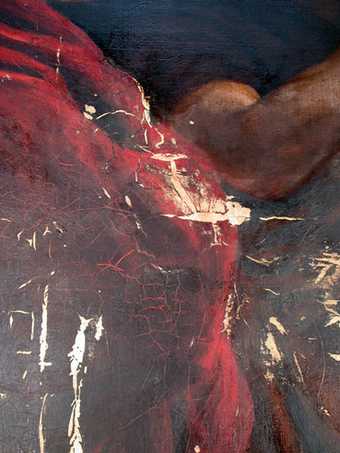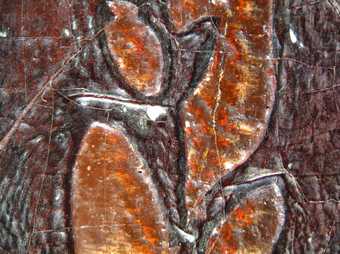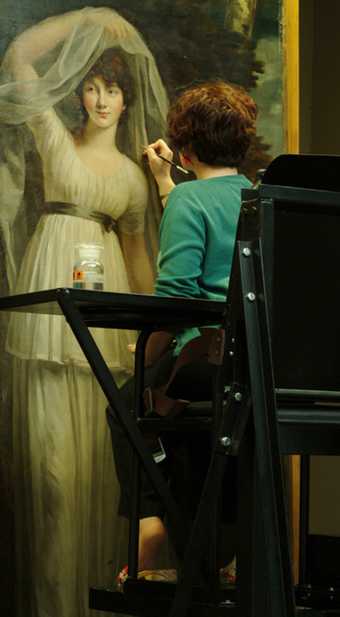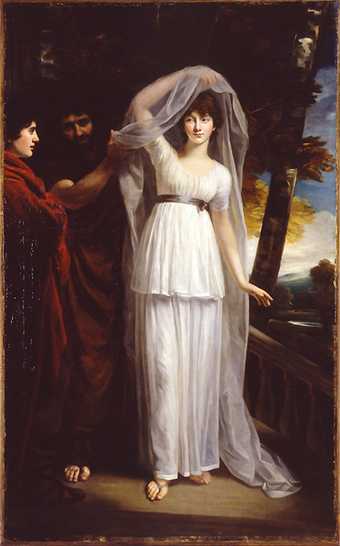
John Opie
Portrait of a Lady in the Character of Cressida exhibited 1800
Oil on canvas; support: 2337 x 1448 mm frame: 2630 x 1735 x 100 mm; painting; before treatment
Portrait of a Lady in the Character of Cressida was inspired by the lines spoken by Pandarus in Act 3, Scene 2 of Shakespeare’s tragedy: ‘Come, draw this curtain, and let’s see your picture’. The painting was first shown at the Royal Academy in 1800.
An initial analysis of the Opie’s work
The lead conservator, Rebecca Hellen, spent weeks working out how to treat it and then removing the many layers of dirt, varnish and over-paint which made John Opie’s painting so dark and difficult to appreciate. Through the early stages of the analysis it became apparent why restorers had been so concerned with repairing cracks in the painting.
Looking for more information on the materials and technique of this Cornish artist and understanding why these cracks developed became essential to the conservation process. It was clear from analysis of the cross-sections that Opie has modified his paints. This means the artist’s oil paint was mixed with additional mediums, such as resin varnish, wax or bitumen. This had created a network of cracks on the surface of the painting, for example in Trolius’s red cloak.
Dealing with the difficult process of varnish removal and deciding which was the best approach to inpainting and then executing it proved a great intellectual and physical challenge. Not only is the surface area of this painting very large but its topography and problems varied from one area to the next, sometimes depending on its colour. A great deal of time and patience is required to treat such a complex and vast surface area.
A reversible treatment

Detail revealing old fills during varnish and overpaint removal in the area of Troilus's red cloak

Detail photomicrograph of the disfiguring crack patterns revealed (at x10 magnification)
In the details of the painting during treatment it is possible to see what lengths the nineteenth-century restorers had gone to in order to disguise these cracks. They were filled with putty made from chalk and animal glue, painted over and then varnished. Until the recent conservation treatment, most of the original drapery in Troilus’s cloak was completely obscured by restorations.

John Opie
Portrait of a Lady in the Character of Cressida exhibited 1800
In-painting during the final stages of the conservation treatment
This time, a very different approach from that of the nineteenth- and early twentieth-century restorers was taken. The damages and disfiguring cracking patterns were painted instead of filled. The surface was inpainted with reversible modern resins mixed with dry pigments in order to disguise areas of loss and damage but left the original texture of Opie’s experimental paints for those who look closely to see.
An opportunity for research and collaboration

John Opie
Portrait of a Lady in the Character of Cressida exhibited 1800, after treatment
Given the complexity of this treatment, the conservator visited other museums and galleries to view their paintings by Opie, discussed their condition with fellow curators and conservators and researched contemporary and nineteenth-century texts. A Century of British Painters written by art historians Richard and Samuel Redgrave in the 1860s provided a chapter on the preservation, materials and techniques of works from this period with specific reference to Opie. This research provided additional information and understanding about some of the processes and materials that Opie used to create the work and a little of the context for his inspirations too.
Following conservation, the painting was displayed at Tate Britain prior to travelling on loan to the exhibition John Opie: A Celebration of the ‘Cornish Wonder’ at the Royal Cornwall Museum in Truro to commemorate the bicentenary of Opie’s death.
